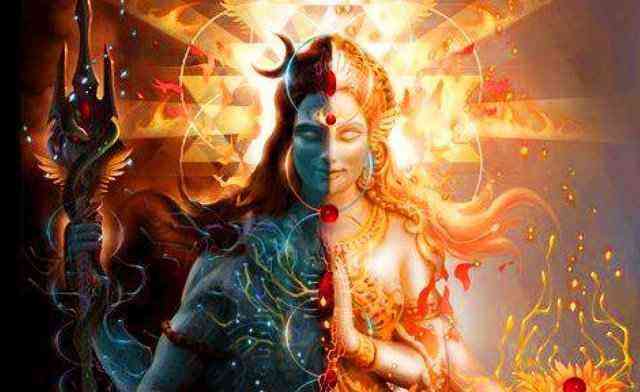Strange as it may seem, in Christianity humans are humans and beasts are beasts. There is a clear distinction between the two and to ignore it is almost blasphemy. Perhaps many Christians would be offended if a scientist speaks of Darwin's theory of evolution in a school in front of children, because Darwin proposed that humans evolved from animals, an argument that is simply unacceptable in the Christian world. In Saivism becoming aware of our animal nature and making a sincere and honest attempt to change it is the first condition and the starting point in our journey towards becoming aware of who we are truly. Whether we admit it on not, we are pasus (beasts) so long as we do not realize our true nature by overcoming our animal nature and become one with our pure consciousness.
Pasas are the bonds that keep the individual souls ignorant of their true Siva nature. The three pasas that are common to all schools of Saivism are anava (egoism or individuality or atomicity), karma (actions that have consequences) and maya (delusion). They are called bonds because they bind the souls or jivas to the limited reality and subject them to temporary ignorance of their true Siva consciousness. They are also known as three impurities (malas). According to Saiva Siddhanta school, the thirty six tattvas or elements (which we have discussed elsewhere), pati, pasu and the three pasas constitute the objective world we (the jivas) recognize as our world.
Pati, pasu and pasa are the three most important concepts of Saivism which are common to all schools of Saivism despite their differences in the interpretation of the relationship between the first and the second. Pati means husband or lord and in Saivism he is Siva, the supreme self himself. Pasu means animal or a being in animal state. The animal state here is in reference to the gross physical state and the impurities which we will discuss later on. All the jivas of the lower planes who are subject to illusion and ignorance and the laws of nature, including we the human beings, are considered to be animals because they are deluded and ignorant and do not know who they are actually. Siva is Pasupathi, the lord and shepherd of these deluded beings.
Strange as it may seem, in Christianity humans are humans and beasts are beasts. There is a clear distinction between the two and to ignore it is almost blasphemy. Perhaps many Christians would be offended if a scientist speaks of Darwin's theory of evolution in a school in front of children, because Darwin proposed that humans evolved from animals, an argument that is simply unacceptable in the Christian world. In Saivism becoming aware of our animal nature and making a sincere and honest attempt to change it is the first condition and the starting point in our journey towards becoming aware of who we are truly. Whether we admit it on not, we are pasus (beasts) so long as we do not realize our true nature by overcoming our animal nature and become one with our pure consciousness.
Pasas are the bonds that keep the individual souls ignorant of their true Siva nature. The three pasas that are common to all schools of Saivism are anava (egoism or individuality or atomicity), karma (actions that have consequences) and maya (delusion). They are called bonds because they bind the souls or jivas to the limited reality and subject them to temporary ignorance of their true Siva consciousness. They are also known as three impurities (malas). According to Saiva Siddhanta school, the thirty six tattvas or elements (which we have discussed elsewhere), pati, pasu and the three pasas constitute the objective world we (the jivas) recognize as our world.
The impurity of anava makes individual jivas believe themselves to be atomic in nature, limited in consciousness and powers or abilities. One of the results of anavamala is the experience of egoism and sense of duality as our true nature, besides becoming subject to the negative feelings of envy, anger, greed, lust and pride. Because of anavamala, jivas become selfish and self centered, lustful and greedy, defensive or offensive and fail to discriminate between good and bad actions. They indulge both kinds of actions to further their own interests or fulfill their desires and aspirations often at a great coast to themselves and to others. This binds them to the second impurity karma.
Karma binds the souls to their actions and makes them pay for it through consequences (effects ) and causation. Souls experience these consequences as pain or pleasure through their experience of union or separation from the desired objects of enjoyment. Maya the third impurity binds the souls to the objects of enjoyment through desires and involves them deeply with the world of phenomenal experience (samsara). Deluded thus by the power of maya they continue their existence as ignorant beings, mistaking the untruth as truth and indulging in actions that would bind them further to the consequences of such actions.
If the three impurities are the cause of our ignorance in the initial stages they are also expected to be the means of deliverance, or that is what nature or prakriti intends to achieve, though in a clumsy and tedious way, as a part of its grand design. Left to nature, the process of liberation with karma as the instrument of correction, the mind as the instrument of knowledge and the body as the instrument of action would take eons. So it is left to the Jivas to find better and more effective means to expedite the process and achieve liberation. The experience of a guru, or an enlightened soul who has already treaded the path and realized his true nature therefore becomes imperative in our journey towards self awareness.
Different schools of Saivism prescribe different methods for the liberation of the jivas from these three bonds. All schools agree that obtaining the grace of Siva is a prerequisite on the path of liberation which usually manifests in the form of personal guidance and blessings from an enlightened guru. The other means of obtaining liberation is through the practice of one or more of methods of charya (physical service), kriya (devotional service), yoga (practice of yoga and meditation) and jnana (gaining knowledge through study, insight and experience).
Depending upon the degree of freedom achieved, Saiva Siddhanta school recognizes three types of souls. Sakalas are those that have become free from all the three pasas. Vijnanakalas are those that have freed themselves from maya and karma. Pralayakalas are those that would become free from maya only when Siva withdraws his entire maya-sakti finally into himself as a part of the dissolution of the worlds.
















0 Comments